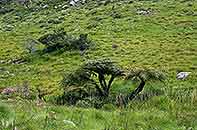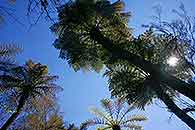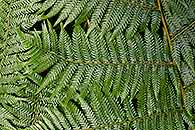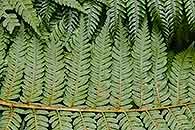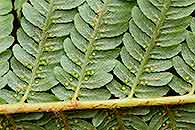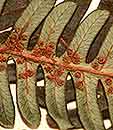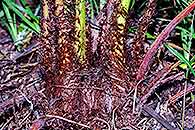Cyathea dregei Kunze
Synonyms |
Alsophila dregei (Kunze) R. M. Tryon |
|---|---|
Common name |
Grassland tree fern |
Description |
Caudex thick, stout, 5 m × 45(-90 near base) cm, without spines and without aphlebia in the crown of the caudex, many old pendulous fronds present. Fronds coriaceous, in whorls. Stipe rough, 30-50 cm long, pale matt brown, sometimes with a pair of very small pinnate pinnae 4-25 cm long at the base; basal scales castaneous, shiny, twisted, up to 40 mm long, apices tapering to a point, margins very narrow fragile bearing an obliquely spreading fringe. Lamina 0.9-3 m × 0.5-0.8 m, 3-pinnatifid to 3-pinnate, elliptic or oblong in outline, yellow-green above, slightly glaucus beneath. Pinnae 12-20 on each side of the rhachis, alternate and at an angle, largest pinnae 40-70 cm long, lower pinnae commonly slightly to much reduced. Ultimate lobes adnate along the costules, oblong, acute, somewhat falcate, margins entire to minutely lobed; costules and veins below with light brown hair-like scales. Sori up to 10 per lobe, round, cup-shaped, situated in 2 rows along each side of the costule; indusium cup-shaped, sometimes with small projections on the margin. |
Notes | This species has a thick trunk and tendency to grow in full sun. |
Derivation | dregei: after Johann Franz Drège (1794-1881), German horticulturalist, botanical collector and explorer who worked extensively in South Africa. |
Habitat | Full sun along open streambanks in grassland, swamp edges, riverine forest, seepage grassland, pits in ironstone, occasionaly in scrub along mountain streams and forest edge. |
Distribution worldwide | Africa, Madagascar. |
Distribution in Africa |
Angola, Burundi, Cameroon, Congo, Dem. Republic of Congo, Equatorial Guinea (incl. Bioko), Ghana, Guinea, Kenya, Lesotho, Liberia, Malawi, Mozambique, Nigeria, Rwanda, Sierra Leone, South Africa, Swaziland, Tanzania , Uganda, Zambia, Zimbabwe. |
Growth form |
Terrestrial. |
Literature |
|

